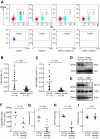Deficient CD4+ CD25+ FOXP3+ T regulatory cells in acquired aplastic anemia
- PMID: 17463169
- PMCID: PMC1975843
- DOI: 10.1182/blood-2007-01-066258
Deficient CD4+ CD25+ FOXP3+ T regulatory cells in acquired aplastic anemia
Abstract
Regulatory T cells are believed to control the development and progression of autoimmunity by suppressing autoreactive T cells. Decreased numbers of CD4(+)CD25(+) FOXP3(+) T cells (Tregs) are associated with impaired immune homeostasis and development of autoimmune diseases. The transcription factors FOXP3 and NFAT1 have key roles in regulatory T-cell development and function. We show that Tregs are decreased at presentation in almost all patients with aplastic anemia; FOXP3 protein and mRNA levels also are significantly lower in patients with aplastic anemia and NFAT1 protein levels are decreased or absent. Transfection of FOXP3-deficient CD4(+)CD25(+) T cells from patients with a plasmid encoding wild-type NFAT1 resulted in increased FOXP3 expression in these cells. By NFAT1 knockdown in CD4(+)CD25(+) T cells, FOXP3 expression was decreased when NFAT1 expression was decreased. Our findings indicate that decreased NFAT1 could explain low FOXP3 expression and diminished Treg frequency in aplastic anemia. Treg defects are now implicated in autoimmune marrow failure.
Figures


References
-
- Beissert S, Schwarz A, Schwarz T. Regulatory T cells. J Invest Dermatol. 2006;126:15–24. - PubMed
-
- Beyer M, Schultze JL. Regulatory T cells in cancer. Blood. 2006;108:804–811. - PubMed
-
- Sakaguchi S. Naturally arising Foxp3-expressing CD25+CD4+ regulatory T cells in immunological tolerance to self and non-self. Nat Immunol. 2005;6:345–352. - PubMed
-
- Shevach EM, DiPaolo RA, Andersson J, et al. The lifestyle of naturally occurring CD4+ CD25+ Foxp3+ regulatory T cells. Immunol Rev. 2006;212:60–73. - PubMed
-
- Gambineri E, Torgerson TR, Ochs HD. Immune dysregulation, polyendocrinopathy, enteropathy, and X-linked inheritance (IPEX), a syndrome of systemic autoimmunity caused by mutations of FOXP3, a critical regulator of T-cell homeostasis. Curr Opin Rheumatol. 2003;15:430–435. - PubMed
Publication types
MeSH terms
Substances
Grants and funding
LinkOut - more resources
Full Text Sources
Medical
Molecular Biology Databases
Research Materials

